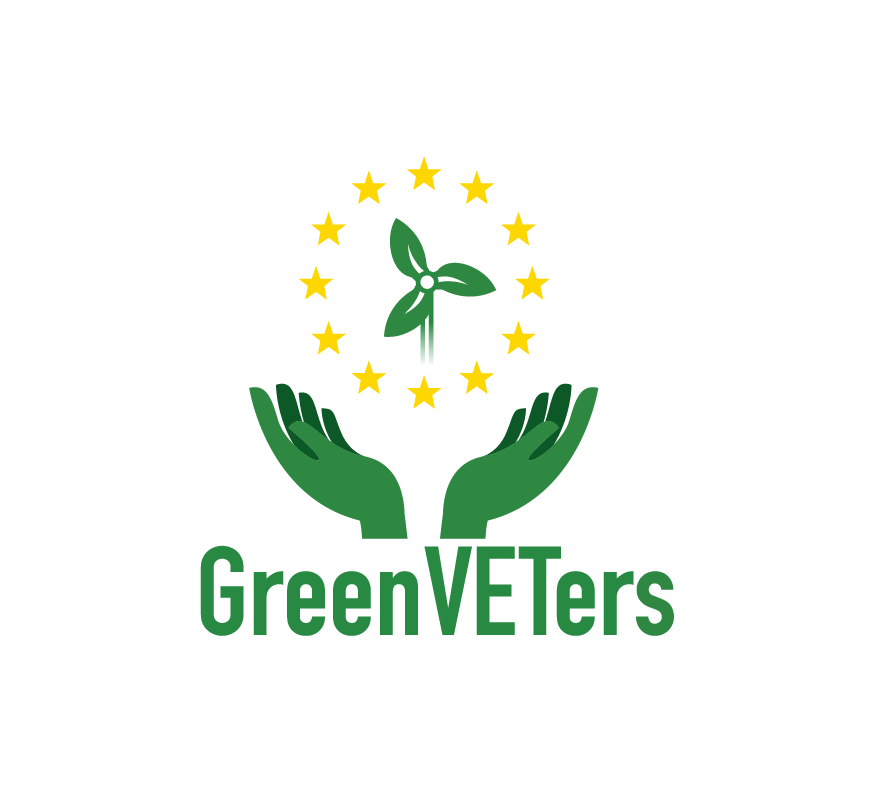Worksheet for Lesson 1:
Climate Change and Environmental Sustainability
Learning Objectives:
1. The students learn and understand what exactly Climate Change, Global Warming, and the Greenhouse Effect are.
2. How are these phenomena connected?
3. The students learn about the importance of biodiversity and the negative impact of climate change on it.
4. Students explore diverse ways to fight climate change.
Learn the Basics
What is the difference between weather and climate?
According to NASA, the term weather refers to the atmospheric conditions that occur locally over short periods, while climate refers to the long-term regional or global average of temperature, humidity, and rainfall patterns. The main difference is time.
The weather is only temporary. The climate, on the other hand, is more than just a few warm or cool days. Climate describes the typical weather conditions in an entire region for a very long time – 30 years or more.
What is the difference between weather and climate?
Weather consists of various phenomena such as sunlight, rain, cloud cover, wind, hail, snow, sleet, floods, blizzards, thunderstorms, heat waves, etc.
Things That make up our Climate
Climate represents the average weather over a vast period and is determined by combining ocean currents and wind patterns.
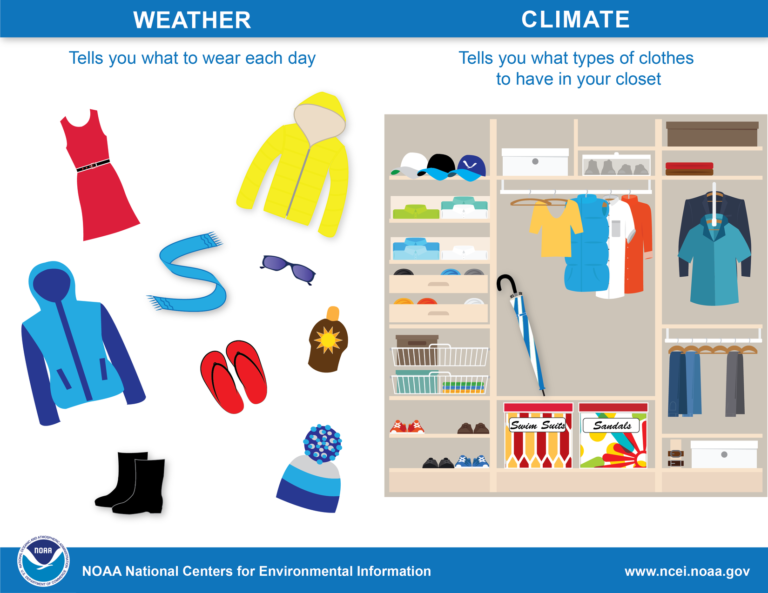
What is climate change?
Earth has been under scientific observation for a very long time. Scientists have gathered vast amounts of data about the five interactive systems that constitute the earth’s climate system: the lithosphere (earth’s upper surface layer), the atmosphere (earth’s thin layer of gases surrounding it), the hydrosphere (earth’s liquid water in oceans and lakes), the cryosphere (earth’s solid frozen water in ice and snow), and the biosphere (earth’s living organisms). According to the information, scientists have been able to extract for the data, the climate of the Earth is getting warmer. As the atmosphere is heating up, the weather patterns are changing and wet areas become wetter, while dry areas become drier.
Alterations in the Earth’s climate are caused by a combination of natural forces, such as volcanic eruptions and variations in solar intensity, and human activity, predominantly releasing heat-trapping greenhouse gases. Climate change relates to the broader range of changes in the earth’s climate system, such as rising sea levels caused by melting ice sheets and glaciers. This term is usually confused, or replaced with Global Warming but they are two distinct definitions. Climate change refers to shifts in temperatures and weather patterns. So, when we are talking about climate change, we are talking about changes in long-term average daily weather. In most places, weather can change from minute to minute, hour to hour, day to day, and season to season.
A glaring example of climate change is the growing seasons changing. Winters are getting shorter, spring is coming earlier, and fewer days are getting below freezing. Numerous life cycle events, such as flower blooming or the emergence of pollinators, are impacted by these changes in timing. Because different species may react differently to environmental cues, resulting in a misalignment between species that may depend on one another, changes in the timing of these events, such as the spring thaw or songbird migration, can have serious effects on ecosystems.
Some interesting facts about climate change in the Global Climate Dashboard are listed below.
• Since the start of the satellite era in 1979, the extent of ice covering the Arctic Ocean at the end of summer has shrunk by more than 40 per cent.
• Earth’s temperature has risen by an average of 0.14° Fahrenheit (0.08° Celsius) per decade since 1880, or about 2° F in total.
• 2022 was the sixth-warmest year on record based on NOAA’s (National Oceanic and Atmospheric Administration) temperature data.
• The rate of global sea level rise is accelerating; it has more than doubled from 0.06 inches (1.4 millimetres) per year throughout most of the twentieth century to 0.14 inches (3.6 millimetres) per year from 2006–2015.
• Averaged over the full depth of the ocean, the global ocean gained an estimated 0.58-0.78 watts of heat energy per square meter from 1993–2021, contributing to sea level rise, ice shelf retreat, and stress on coral reefs.

What is global warming?
As the human population increases, its energy needs increase accordingly. The effort to cover those needs in combination with our inability as a species to use renewable energy sources effectively, has led to the burning of vast amounts of fossil fuels. Fossil fuels include coal, oil, and natural gas. The burning of these materials releases into the atmosphere gases that absorb some of the sun’s heat, slowly making the earth warmer. These gases are known as greenhouse gases and their effect on the earth’s temperature is known as the greenhouse effect. Since the Industrial Revolution, greenhouse gas levels in the atmosphere have steadily increased, aggravating the issue.
The planet is getting hotter, and we can see extreme increases in the global annual temperature over the years. The Earth’s average surface temperature has increased by about 1.0°C (1.8°F) since the late 1800s. This phenomenon is more evident in the Arctic pole during its cool seasons and in Earth’s mid-latitude regions during the warm seasons.
Many climate scientists agree that if the global average temperature increased by more than 2 °C (3.6 °F) in such a short period, societal severe, economic, and ecological harm would follow. A few degrees make a huge difference in the planet’s vital signs.
What causes global warming?
2011-2020 was the warmest decade recorded. In 2019, the global average temperature reached 1.1°C above pre-industrial revolution levels. Human-induced global warming is increasing at a rate of 0.2°C per decade. But what causes global warming?
In the previous sector, we briefly talked about the Greenhouse Effect. It is essential to clarify that the Greenhouse Effect is not inherently bad. The complete opposite is true. Without the Greenhouse effect, the temperatures would be cooler, and many life forms would freeze. The Greenhouse Effect is crucial to life as we know it, making the Earth’s temperature suitable for living.
How does it work exactly? During the day, the Sun shines through the atmosphere. Earth’s surface warms up in the sunlight. At night, Earth’s surface cools, releasing heat back into the air. But some of the heat is trapped by the greenhouse gases in the atmosphere. That’s what keeps our Earth warm and cosy 14 degrees Celsius, on average. However, human activity is causing a lot more greenhouse gases to be released into the atmosphere and as a result, more heat is trapped. Consequently, the earth’s temperature is increasing too much. Greenhouse gases have been identified as the biggest factor contributing to global warming.
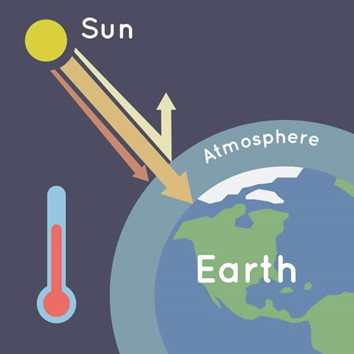
Let’s see below how these gases work in the atmosphere.
Water vapour is abundantly found in the earth’s atmosphere and contributes more to the greenhouse effect than any other greenhouse gas. However, unlike the rest of the greenhouse gases, it does not control the earth’s temperature. Contrary, it is the earth’s temperature that controls the amount of vapour in the atmosphere.
Since warmer air retains more moisture, the rise of the earth’s temperature leads to more vapour in the air, retaining more heat. And thus, a positive feedback loop is created. The loop is presented in the diagram below.

Carbon dioxide (CO2) is the most significant of the greenhouse gases. Outgassing from volcanoes, the combustion of all carbon-based fuels, from organic matter’s natural decomposition, and aerobic (oxygen-using) organisms’ respiration, CO2 is widely considered the ‘king’ of the greenhouse gases, and because of human action, its concentration in the atmosphere has doubled since the beginning of the industrial revolution. CO2 sources are typically counterbalanced by a collection of “sinks”—a collection of physical, chemical, or biological processes—that remove CO2 from the atmosphere, such as terrestrial vegetation, which absorbs CO2 through photosynthesis.
Burning fossil fuels—primarily coal and oil, and secondarily natural gas—for transportation, heating, producing electricity, and manufacturing cement- are the main ways human activities raise atmospheric CO2 levels. The burning of forests and land clearing are examples of additional anthropogenic sources.
Methane (CH4), is a hydrocarbon that is a primary component of natural gas. Methane is the second most abundant anthropogenic greenhouse gas after carbon dioxide (CO2), accounting for about 20% of global emissions. It is particularly potent at sustaining heat in the atmosphere.
In fact, it is 25 times stronger than carbon dioxide in that aspect. As with CO2, human
activity is raising the concentration of CH4 faster than natural sinks can reduce it. Approximately 70% of all annual emissions are currently attributed to anthropogenic sources, which has resulted in significant concentration increases over time.
Rice farming, livestock farming, burning coal and natural gas, burning biomass, and decomposition of organic matter in landfills are the main anthropogenic sources of atmospheric CH4.
Additional trace gases produced by industrial activity that have greenhouse properties include nitrous oxide (N2O) and fluorinated gases (halocarbons), the latter including sulfur hexafluoride, hydrofluorocarbons (HFCs), and perfluorocarbons (PFCs). Nitrous oxides have small background concentrations due to natural biological reactions in soil and water, whereas the fluorinated gases owe their existence almost entirely to industrial sources.
An important anthropogenic radiative forcing of climate is the production of aerosols. The word aerosol means ‘atmospheric particulate’, but during the 80s and 90s, the media used it as a reference to spray cans that released chlorofluorocarbons (CFCs) and in more recent years hydrochlorofluorocarbons (HCFCs). CFCs’ most widely known side effect is their damaging properties to the ozone layer. Their negative influence does not stop there. Despite them not having a significant impact on the overheating of the planet, they do cause changes in the climate of the planet by affecting rain patterns and altering winds and atmospheric circulation.
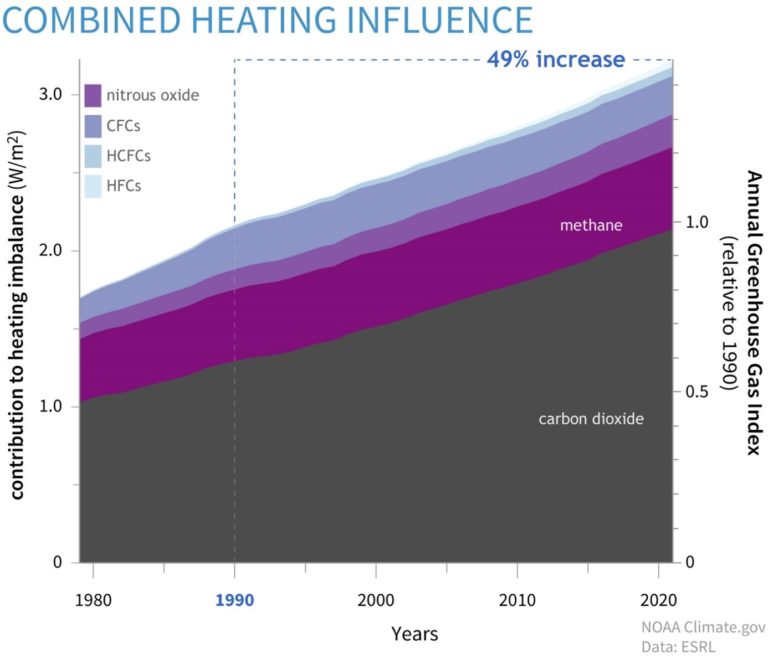
Causes for rising emissions
• Burning coal, oil and gas produces carbon dioxide and nitrous oxide.
• Cutting down forests (deforestation). Trees help to regulate the climate by absorbing CO2 from the atmosphere. When they are cut down, that beneficial effect is lost and the carbon stored in the trees is released into the atmosphere, adding to the greenhouse effect.
• Increasing livestock farming. Cows and sheep produce large amounts of methane when they digest their food.
• Fertilizers containing nitrogen produce nitrous oxide emissions.
• Fluorinated gases are emitted from equipment and products that use these gases.
Effects of Climate Change
• Hotter temperatures. As greenhouse gas concentrations rise, so does the global surface temperature.
• Ice is melting at the North and South Poles, causing many animals such as polar bears, seals, and penguins to lose their habitat.
• Increase extreme weather phenomena such as storms, heat waves, droughts, and floods.
• A warming, rising ocean threatens many species of marine life while also threatening Earth’s coastal areas and islands.
• Trees and plants blossom much earlier in the year.
• Extinction of many species of insects and animals. Loss of biodiversity and collapse of whole ecosystems.
• Reduction of food production due to extreme weather conditions. Health risks on humans due to low quality of air.
• Poverty and displacement.
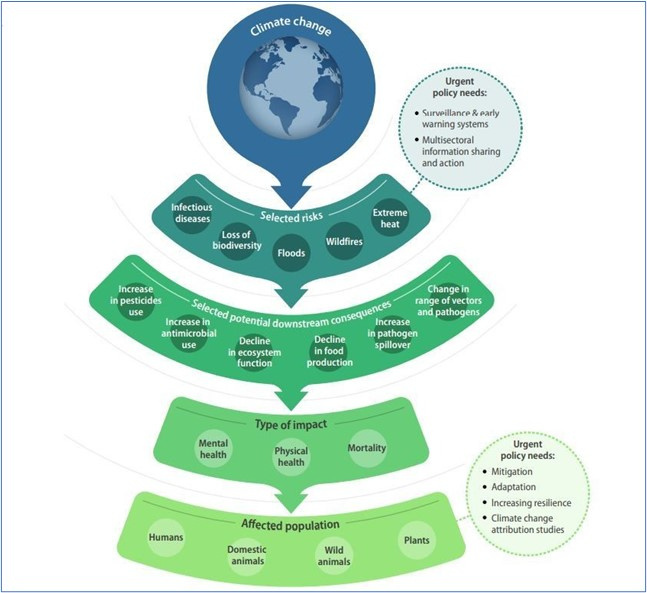
What is Biodiversity and why do we need to protect it?
“Biodiversity” or biological diversity is the scientific term for the variety and variability of life on Earth. In other words, all the different kinds of life that make up the natural world. All living organisms exist in their own communities, known as ecosystems.
What is an ecosystem? It is a geographical area where different species of plants, animals, and other organisms coexist harmoniously with the environment, including the climate and landscape.
Every part of an ecosystem is directly or indirectly reliant on each other. For example, if an ecosystem’s temperature changes, the types of plants that can grow there will be affected. Animals that rely on those plants for food and shelter will have to relocate to another ecosystem or die.
Biodiversity is directly responsible for making the earth suitable for living. Every living organism works to maintain the function of the ecosystem they belong to, providing balance and supporting life. Biodiversity provides clean air, water, food, and fuel.
Unfortunately, humans have disturbed the balance of their ecosystems. Unbalanced ecosystems can no longer support life and the biodiversity of our planet is under severe threat.
Species are forced to move out of their natural habitats as these regions are becoming uninhabitable due to climate change. Local extinction is possible for populations that cannot migrate or adapt, such as some plants and insects. According to Nasa, at 1.5 degrees Celsius warming, insects, plants, and animals will see their climatically determined geographic range reduced by more than half.
The United Nations Environment Program (UNEP) established the Aichi Targets, which were a component of the Strategic Plan for Biological Diversity (2011-2020). The Aichi Targets was a set of 20 goals to slow down the loss of biodiversity on the planet, but as the deadline of the Strategic Plan came and passed, it was clear that none of the goals was fully achieved.
Slowing down biodiversity loss is one of humanity’s great challenges. The Global Biodiversity Outlook published in September 2020 indicates that we are failing to meet the targets set for eliminating biodiversity destruction.
How does the EU act to protect biodiversity?
The EU’s biodiversity strategy for 2030 is a detailed, ambitious, and long-term plan to preserve the environment and stop ecosystem degradation. The strategy includes specific commitments and actions that are meant to put Europe’s biodiversity on a path to recovery by 2030.
A shared framework for peace and prosperity for the people and the planet, both now and in the future, is provided by the 2030 Agenda for Sustainable Development, which was adopted by all United Nations Member States in 2015. The 17 Sustainable Goals (SDGs) are an urgent call to action for all nations.
Specifically, the Sustainable Development Goal 15 of the 2030 Agenda for Sustainable Development is devoted to “protect, restore and promote sustainable use of terrestrial ecosystems, sustainably manage forests, combat desertification, and halt and reverse land degradation and halt biodiversity loss”. According to the EU, resource extraction and processing are responsible for 90% of biodiversity loss.
Members of the European Parliament (MEPs) strongly supported the EU targets of protecting at least 30% of the EU’s marine and terrestrial areas (forests, wetlands, peatlands, grasslands, and coastal ecosystems) and that 10% of the EU’s oceans and land, including all remaining primary and old-growth forests and other carbon-rich ecosystems, should be left essentially undisturbed. Most MEPs want the targets to be binding and implemented by EU countries at the national level, in cooperation with regional and local authorities.
In accordance with intergovernmental conventions like the Convention on Biological Diversity and the Convention on International Trade in Endangered Species of Wild Fauna and Flora, the EU actively participates in ensuring that the world respects its obligations to protect nature and biodiversity. The European Council conclusions of October 2022, served as the EU’s overall negotiating position for the 15th United Nations Biodiversity Conference (COP 15), held in Canada in December 2022. At the conference, a post-2020 global biodiversity framework was adopted, outlining specific objectives intended to direct global actions to protect and restore nature by 2030 and beyond.
In addition, already-adopted legislation supports the EU’s efforts to stop the destruction of ecosystems and biodiversity. This includes the Habitats Directives, the Water Framework Directive, and the EU Marine Strategy Framework Directive. These legislative frameworks are essential to the conservation of biodiversity in the European ecosystems.
Moreover, in 2022, the European Commission for the first time proposed a new continent-wide law, aiming at the revival of damaged ecosystems. The Nature Restoration Law is a critical element of the EU Biodiversity Strategy and calls for binding targets to restore degraded ecosystems, especially those with the greatest potential to absorb and store carbon, as well as to prevent and reduce the impact of natural disasters.
Restoring wetlands, rivers, forests, grasslands, marine ecosystems, and the species they host will help;
• increase biodiversity
• secure the things nature does for free, like cleaning our water and air, pollinating crops, and protecting us from floods
• limit global warming to 1.5°C
• build up Europe’s resilience and strategic autonomy, preventing natural disasters and reducing risks to food security
• enable the long-term and sustained recovery of biodiverse and resilient nature contribute to achieving the EU’s climate mitigation and climate adaptation objectives
• meet international commitments
The proposal aims to restore ecosystems, habitats and species across the EU’s land and sea areas to;
• enable the long-term and sustained recovery of biodiverse and resilient nature contribute to achieving the EU’s climate mitigation and climate adaptation objectives
• meet international commitments
Solutions to climate change
In the battle against climate change, humanity’s action plan accords with these three pillars of response: Adaptation, Mitigation, and Resilience.
Solutions to climate change
The term “adaptation” describes the adjustment to the reality of life in a changing climate. Humanity must adapt to survive the incoming consequences of our destructive actions on the planet. Rising sea levels, droughts, storms, and other extreme phenomena will get increasingly more dangerous in the coming years. Not to mention the probability of food and freshwater shortages. “Adaptation” encourages everyone to consider our likely climate future and prepare in advance. Reducing our vulnerability to the negative effects of climate change is the goal.
Mitigation
‘’Mitigation” means making the impacts of climate change less severe, by preventing and reducing greenhouse gas emissions. Mitigation can describe human intervention aiming at the reduction of emissions and stabilization of the levels of heat-trapping greenhouse gases in the atmosphere. Mitigation and adaptation are the two actions which contribute to the United Nations Framework Convention on Climate Change. Mitigation solutions usually cover technologies and techniques that are utilized in four main sectors: power, on the supply side of energy and industry, transportation, and buildings on the demand side of energy. Conventional mitigation efforts include the application of established technologies and techniques that reduce CO2 emissions, such as the usage of renewable energy sources and nuclear power to produce electricity or carbon capture and storage utilization. Unconventional mitigation efforts include the utilization of a new set of technologies known as negative emissions technologies. Negative emissions technologies include bioenergy carbon capture and storage (BECCS), ocean fertilization to enhance the CO2 absorbing properties of plankton, and alternative negative emissions utilization and storage techniques, that force CO2 to chemically react with other minerals to form stable carbonates that can be safely stored or used in other applications.

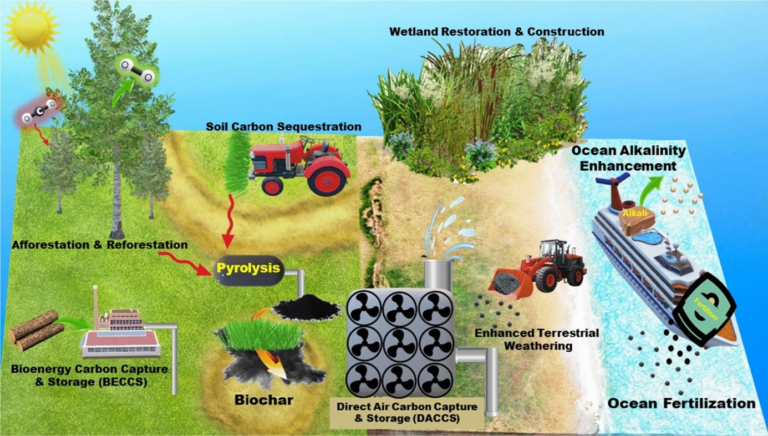
The new EU strategy is comprised of the following points:
• The EU ensures that all its policies and actions work towards increasing Europe’s resilience to the impacts of climate change.
• The EU helps national, regional, and local authorities as well as partners in the private sector to adapt to climate change.
• Globally, the EU promotes international climate resilience and adjustment, while boosting international finance to support international climate resilience and prevention.
Resilience
Climate resilience is the ability to respond to and prepare for risky events, related to climate, like heat waves, hurricanes, or wildfires. However, good resilience planning also accounts for chronic events, like rising sea levels, worsening air quality, and
population migration. One of the 5 EU Missions launched by the European Commission in September 2022 is the mission on adaptation to Climate Change. The EU intends to use the urgent need for climate change adaptation as an opportunity to build a resilient, climate-ready, and equitable Europe. The goal is to support at least 150 European regions and communities to become climate resilient by 2030.
Environmental Sustainability - Definitions
Sustainability is the ability to maintain or support a process over time. Economic, environmental, and social sustainability are the three main concepts that are usually separated. Governments and businesses have made commitments to pursue sustainable objectives, like lowering their environmental impact and conserving resources.
Environmental sustainability is the principle of improving the quality of human life without overstretching the ability of the earth’s ecosystems to support it. It is our responsibility to conserve natural resources and protect the global ecosystem to accommodate the current and future health and well-being of all life on the planet.
Sustainable development is defined as the economic expansion that is planned and carried out while taking sustainability and environmental protection into consideration. In practical terms, sustainable development is the utilization of an ecosystem’s resources and space without damaging its ability to regenerate and support itself.
Why is Environmental Sustainability Important?
Preservation protects the environment from harmful human activities. Healthy ecosystems clean our water, maintain our soil, regulate the climate, recycle nutrients, and provide us with food. They offer the resources and raw materials for anything we create and anything necessary for us to live. They support our economies and constitute the foundation of all civilization. Humanity simply cannot survive without these “ecosystem services”. We refer to them as our natural capital.
How can we achieve sustainability?
Sustainability is the foundation for today’s leading global framework for international cooperation- the 2030 Agenda for Sustainable Development and its Goals. The UN offers 17 goals for sustainable development that act as the path to achieving a more sustainable future.
These goals address global challenges like:
• Ensuring access to clean water and sanitation for all Reducing water waste. Taking a proactive stance in the battle against global warming.
• Reducing the use of plastic to limit the microplastic contamination of the environment.
• Battle deforestation by increasing the earth’s forest and jungle areas- Make cities greener.
• Responsible consumption and production- Recycling items such as paper, plastic, glass, and metal.
• Create sustainable cities and communities- Limit car use by cycling, walking, or public transportation.
Harvesting natural resources
• Hand Harvesting: The most basic way is hand harvesting, which involves picking crops by hand without the use of any tools. This method is typically used for delicate crops such as vanilla beans or saffron.
• Harvesting Tools: Another method is harvesting with hand tools, which involves the use of tools like shears to cut produce like fruits from trees. After picking, the product is placed in a container before being taken from the field.
• Machinery: For larger operations, farmers may use machinery to speed up the harvesting and packing process. Combines and mowers are commonly used in the field to harvest crops efficiently.
• Long-term agricultural production, by improving crop rotation, soil management, and conserving soil quality and water availability.
• The saving of natural capital, by preserving, recycling, replacing, and maintaining the natural resource base, including soil, water, and biodiversity.
How can we protect the ecosystems?
Protecting ecosystems is critical for maintaining the balance of our planet’s natural resources. There are several simple actions that individuals can take to make a difference and join global communities with environmental actions.
Below are some useful examples.
Save the bees: One of the significant threats to bees is the lack of safe habitat where
they can build homes and find a variety of nutritious food sources. Planting a bee- friendly garden can create a habitat corridor with plants that are rich in pollen and nectar. You can even buy a beehive and extract your honey as a new hobby.
Plant trees: Trees are vital for providing food, oxygen, and shade. They also help save energy, clean the air, and combat climate change. Planting a tree is a simple action that can make a significant difference in your local ecosystem.
Use Water wisely: Water is a valuable resource in every ecosystem. You can save water every day by changing small habits. Turning off the tap while brushing your teeth, using vegetable-boiled water for watering plants, and taking shorter showers are all simple ways to conserve water.
Start Composting: Composting organic matter reduces landfill waste and creates healthy soil to feed your garden. You can use easy composting systems at home, such as a compost bin, tumbler, or worm farm.
Volunteer for a Cause: There are various global communities where you can join and be part of actions all over the world for environmental protection. Volunteering your time, skills, or resources can make a significant impact on the planet’s health.
Choose sustainably: Driving less, buying less, and upcycling are all sustainable choices that can reduce your carbon footprint and promote a healthy ecosystem. By making small changes to our daily habits, we can protect the environment and contribute to a healthier planet for future generations.
References:
https://climateknowledgeportal.worldbank.org/overview
https://education.nationalgeographic.org/resource/global-warming
https://www.climate.gov/maps-data/climate-data-primer/past-climate
https://climate.nasa.gov/global-warming-vs-climate-change/
https://www.unep.org/resources/global-environment-outlook-4
https://sdgs.un.org/goals/goal15
https://unfccc.int/topics/adaptation-and-resilience/the-big-picture/introduction
https://www.britannica.com/story/a-recent-history-of-climate-change
https://unfccc.int/process-and-meetings/what-is-the-united-nations-framework- convention-on-climate-change
https://royalsocietypublishing.org/doi/full/10.1098/rsta.2010.0271
https://link.springer.com/article/10.1007/s10311-020-01059-w#Sec6
Wiggins JW, Zimmerman K, Baranowski C, Fries S, Horansky A. Adapting to a Changing Climate: EPA’s Climate Resilience Evaluation and Awareness Tool. Journal: American Water Works Association. 2022;114(10):42-50. doi:10.1002/awwa.2016
https://www.un.org/en/global-issues/climate-change
https://www.ipcc.ch/
https://www.c2es.org/wp-content/uploads/2019/04/what-is-climate-resilience.pdf
European Commission, Directorate-General for Research and Innovation, EU Missions : adaptation to climate change : concrete solutions for our greatest challenges, Publications Office of the European Union, 2021,
https://data.europa.eu/doi/10.2777/88566
https://www.investopedia.com/terms/s/sustainability.asp https://education.nationalgeographic.org/resource/ecosystem/
https://www.farms.com/news/what-are-the-different-methods-of-harvesting-crops- 181640.aspx
https://www.avirtech.co/what-is-the-difference-between-traditional-and-modern-farming
https://education.nationalgeographic.org/resource/preservation/
https://ec.europa.eu/environment/nature/biodiversity/intro/index_en.htm
https://ideas.repec.org/p/pra/mprapa/24119.html
https://youmatter.world/en/definition/ecosystem-definition-example/
https://www.climate.gov/maps-data
https://www.britannica.com/science/global-warming/Surface-level-ozone-and-other-compounds
https://www.mdpi.com/2073-4433/11/10/1095
It's Quiz Time
Here’s a fun quiz that you could use to test your understanding of the key concepts covered in this lesson: 0 of 10 Questions completed Questions: You have already completed the quiz before. Hence you can not start it again.
Quiz is loading… You must sign in or sign up to start the quiz. You must first complete the following:
0 of 10 Questions answered correctly
Your time:
Time has elapsed
You have reached 0 of 0 point(s), (0)
Earned Point(s): 0 of 0, (0) What is the difference between weather and climate? What is the main cause of global warming? What is biodiversity? How is biodiversity threatened by climate change? What is environmental sustainability? What are some strategies for mitigating climate change? How can individuals take action to fight climate change? What is the EU doing to protect biodiversity? What is adaptation in the context of climate change? Why is it important to protect ecosystems?
Quiz Summary
Information
Results
Results
0 Essay(s) Pending (Possible Point(s): 0)
Categories
1. Question
2. Question
3. Question
4. Question
5. Question
6. Question
7. Question
8. Question
9. Question
10. Question
